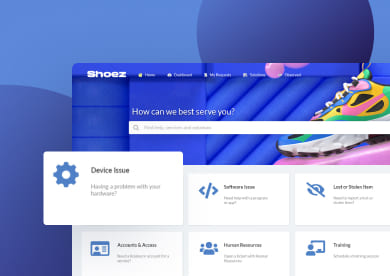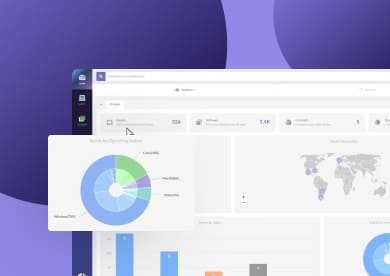A proof of concept (PoC) is your best ally when it comes to choosing software, especially something as central as a service desk. Making an informed decision takes more than reading spec sheets and watching demos. You’ll want to know how it behaves in your real environment.
Before you commit, a PoC lets you test the product, see how it fits your workflows, and check if the vendor’s promises hold up under your conditions. In the case of ITSM platforms, for example, a proof of concept could reveal whether the software plays well with your existing infrastructure, adapts to your processes, or causes new friction points.
Let’s take a closer look at what a PoC is, how to use it in the software selection process, and why it’s especially useful when evaluating service desk solutions.

What is a proof of concept?
A proof of concept is a small-scale test to validate whether a product or approach is viable for your use case. In the context of software, it’s typically a short-term deployment that allows teams to experiment with key features, integrations, and user experience before making a long-term commitment.
The goal isn’t to implement the full solution. Instead, it’s to confirm whether the core functionalities deliver value and whether the tool is worth adopting.
Let’s say you’re looking for a new IT service management (ITSM) platform. Before investing in licenses or migrating your data, you could request a PoC to test how it handles ticket routing, automation rules, and asset visibility. That hands-on evaluation can help you avoid misalignment between the product’s capabilities and your needs.
Proof of concept examples
The scope of a proof of concept varies depending on the product and the use case. In software, it typically covers:
- Setting up a small test environment or sandbox.
- Running a limited number of use cases (e.g., creating incidents, approving requests).
- Connecting the tool to existing systems or data sources.
- Inviting a small group of users to test functionality.
Here are a few examples of PoC for software:
- IT asset management software: A team might request a PoC to see if the tool can automatically detect devices across different networks, align with procurement data, and generate useful lifecycle reports.
- Monitoring tools: Before implementing an observability solution, engineers may test how it handles alerts, supports log aggregation, and integrates with their existing incident response setup.
- Project Management platforms: Organizations often test whether the tool adapts to their preferred workflows, supports cross-team collaboration, and gives stakeholders visibility without manual updates.
- Service desk software: Since this tool connects users, IT staff, and backend systems, a PoC helps validate everything from ticket routing to reporting accuracy. It’s also a chance to test vendor responsiveness. We'll explore this example further in the next section.
Why is it important to create proof of concept?
A proof of concept helps reduce uncertainty during the software selection process. Instead of relying solely on vendor claims or polished demos, it gives your team the opportunity to see the tool in action on your terms. This approach helps identify limitations early, assess usability, and validate whether the software fits your workflows and expectations. It also brings technical and non-technical stakeholders into the process, offering a shared reference point for decision-making.
In short, a PoC saves time and resources by preventing full-scale implementations of tools that aren’t the right fit.
Service desk proof of concept
Take our service desk software example. It’s often the front door to IT, where requests, incidents, and approvals converge. ITSM software implementations are hard because they are one of the most interconnected components in IT operations. Beyond ticket handling, it also touches other systems, like Asset Management, identity providers, monitoring tools, and knowledge bases.
If the tool doesn’t work well for your team or isn’t flexible enough to support your internal processes, it can quickly become a bottleneck. A help desk also needs to reflect your workflows accurately, not force you to adjust them to fit the product. That’s why testing it in your environment is critical.
A proof of concept will add a layer of confidence. For a service desk, a proof of concept will let you:
- Validate the ease of configuration.
- Test core workflows like ticket escalation and categorization.
- See how reporting tools reflect your data structure.
- Evaluate how responsive the vendor is during onboarding and troubleshooting.
The service desk has a lot of moving parts: multiple user roles, automation rules, approvals, SLAs. A PoC helps confirm whether the software can handle that complexity without added friction.
It’s also a chance to assess vendor responsiveness. A provider that supports you during the PoC is more likely to be a reliable partner once the software is in production. Conversely, if their team is hard to reach or reluctant to support you in this instance, that’s a red flag for the long term.

Now let’s go through the key steps to create a useful proof of concept.
5 steps to create a proof of concept
- Define success criteria
Identify the problems you’re trying to solve and which features matter most. Write down your must-haves, nice-to-haves, and blockers. - Select realistic use cases
Focus on a few core scenarios that will reveal how the tool performs under normal conditions. For ITSM tools, this could be incident triage or change request approvals. - Pay attention to vendor support
Ask the provider to guide the setup and help replicate your environment. Pay attention to how responsive and helpful they are throughout. - Gather user feedback
Involve a small group of potential users. For a Service Desk, that will include agents or analysts, and maybe some end-users. Ask them to log tickets, test automations, and explore dashboards. - Evaluate results and decide
Compare outcomes with your success criteria. Did the tool meet your expectations? Did it simplify or complicate key tasks?
In short
A proof of concept helps you reduce risk during software selection. It gives you the chance to evaluate a tool’s real-world performance before making a commitment. In service desk scenarios, a PoC can help surface configuration issues, integration gaps, or usability challenges early, when it’s still easy to walk away.
If you’re investing in critical software, like a new ITSM platform, a well-defined proof of concept should be a non-negotiable part of your decision-making process.















